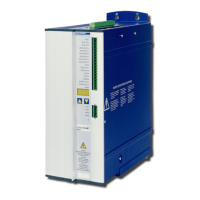6.2.8 Digital speed & Servo Pump (Opmode -7)
Usable with S300 and S700 only.
PZD 1 PZD 2 PZD 3 PZD 4 PZD 5 PZD 6
STW Pressure
setpoint
Volume-flow
setpoint
- - -
ZSW Pressure
actual value
Volume-flow
actual value
Current
actual value
Actual position
Bits 16...32
Actual position
Bits 0...15
The 16 bit values for pressure setpoints/actual pressure values are specified in 10 mBar steps.
The 16 bit values for volume-flow setpoint/volume-flow actual value are specified in 0.1 l/min
steps.
When operating mode -7 is activated, QENA is automatically set to 1. When switching over to an
operating mode other than -7, the servo pump is deactivated (QENA=0).
PNUs 1780...1820 see ASCII Object Reference, group "Servo pump".
6.2.9 ASCII channel (Opmode -16)
PZD 1 PZD 2 PZD 3 PZD 4 PZD 5 PZD 6
STW 10 bytes of ASCII-data
ZSW 10 bytes of ASCII-data
The operating mode “ASCII-channel” is used for parameterizing the servo amplifier. With this
channel, just as with any terminal program, ASCII data can be exchanged with the servo amplifier
via the RS232 interface. The control of the communication is performed by handshake bits in the
control and status words. The assignment is as follows:
Bit 12: Control word
Any transition edge on this bit informs the servo amplifier that valid ASCII data are available in its
process data input section, i.e. that with effect from this moment valid data must have been
entered into the PZD transmission section PZD 2 PZD 6 by the control system.
Bit 12: Status word
The servo amplifier confirms that it has accepted the ASCII data, by a transition edge on this bit.
Bit 13: Status word
The servo amplifier uses a “1” in this bit to signal that the ASCII buffer now contains valid data. A
transition edge of Bit 14 in the control word STW can be used to make the servo amplifier write the
buffer contents to the PZD reception section of the bus-master.
Bit 14: Control word
Any transition edge on this bit requests the servo amplifier to write the contents of its filled ASCII
buffer to the receive process data of the bus master
Bit 14: Status word
The servo amplifier uses a transition edge on this bit to signal that the ASCII buffer data have
been written to the process data.
When transmitting ASCII data, you must observe:
Every ASCII command must be terminated by the “CR LF” character sequence.
If the ASCII command (with CR LF) is shorter than the 10 characters that are available, then
the rest of the telegram must be filled up with bytes with a content 0x00.
ASCII commands that are longer than 10 characters must be divided into more than one tele-
gram, where maximum 30 characters can be sent before the buffer must be read out once.
When evaluating the responses to the transmitted ASCII command, you must observe:
The ASCII response is always terminated by an “End of Text” (EOT = 0x04) character.
Response telegrams can include less than 10 bytes of user data, without the response being
concluded. The telegram must then be filled up with bytes with the value 0x00.
After reading out the buffer, Bit 13 of the status word is reset to “0”, until the buffer is filled
again. The designation of the end of the ASCII response is in all cases “End of Text”.
6.2.10 Operating mode after switch-on (Opmode -126)
In this state, it is possible to control the state machine, but motion functions cannot be initiated
(➜ # 27).
S300-S400-S600-S700 PROFIBUS | 6 Process data channel
Kollmorgen | kdn.kollmorgen.com | December 2019 45

